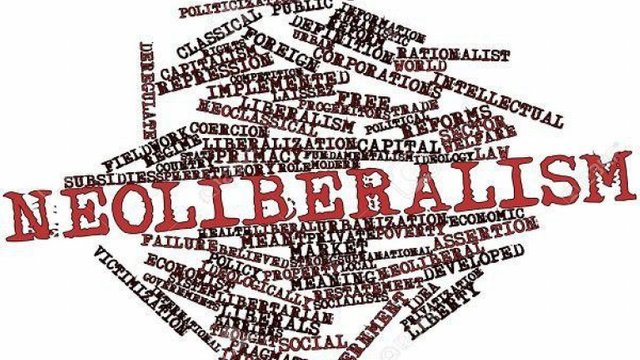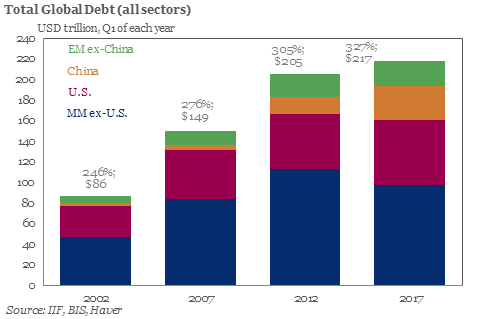Debt Trap - From Fairytale to Nightmare
The original content "Pasti zadolževanja – od pravljice do more" is from Črt Tavš, Slovenian economy blogger. I just made Slovenian-English translation.
Data on global indebtedness and global gross national income are different. Reuters states that the global debt of 215 trillion US dollars has reached a level of 325% of the world's gross national income. In 2018 it's reaching 233 trillion US dollars already.
Of this, one third is expected to account for global public debt, while the remaining part is burdened by the private sector (households and businesses). From the economic point of view, the world should go bankrupt, but it continues to spin its way under the sun. What are they hiding, or how can we explain this?
The breakdown of social societies and the rise of neoliberalism
After the Second World War and until the mid-1970s, European countries developed, unlike the United States, into social societies. There was a balance between capital and work, as a result of strong union struggles and the influence of the Soviet Union in that time. As a result, profits on capital declined.

The influence of technical and technological innovations (computing, telecommunications, transportation ...) in the sixties and seventies changed the way of global production. Previously, production was carried out within individual countries, and then the production processes were organized globally, which changed the world into one market. This resulted in suppression of acquired labor and social rights and the rise of neoliberalism. Its effect is undermining any social and environmental constraints, stating that the balance of power will bring the power of a free market, which will accelerate the overall well-being.
Defeat of workers' movements
Economic crises emerged after 1980, because the corresponding social distribution was not realized. On the contrary, the range between the rich and the impoverished has increased. In the first serious crisis, this model stumbled due to the saturation of the market with products and services and the reduced purchasing power.
At this point, the neoliberal model responded with a financial intervention: if an adequate profit from the sale of goods can not be ensured, it can be realized or even increased by trading financial products.
For example: annual trade international trade is about 20 trillion US dollars, equal to five daily turnover in financial markets. From one hundred transactions, related to cereals, there is only one related to production or distribution, others are among representatives who have no connection to cereals. They determine the price.
The process of financialization was the result of the defeat of workers' movements. it was created in the conflict between capital and work, thus enabling the introduction of borrowing. For the needs of people in the past, their pay was sufficient. This has been decreasing, so they had to borrow so that they could cover their living needs. This process was also in crisis due to the creation of financial balloons, which began to crumble after a shorter chronological order. At some point in time, the neoliberal model of management has the need to invest some of its resources into reality in order to reduce the risk of financial baloons and thus survive. As it faces the saturation of the market, it forces the purchase of goods that people did not buy in the past. For this transition, it is characteristic of turning rights into purchasing power, for example, that education is not a right, but a product and only one who has money will be educated.
When the fairy tale turns into a nightmare
The attack on public good and social rights represents its continuation for the model in question and a source of sustained and reliable profits. The systemic crisis of neo-liberalism dictates the placement on the market of what was previously publicly regulated: health, education, infrastructure, water, and so on.

The public no longer believed in the fairy tale of the free market and its welfare, and therefore a shock was called a public debt. Shock serves to turn the former fairy tale into a nightmare. The debt trap is a form of "coup d'etat" in the context of freedom.
We are used to the fact that the relationship between the lender and the borrower is equal and we always behave accordingly. Indeed, there is a long relationship of power between those who have resources and power and those who have to borrow in order to meet the standards of the social environment.
The debt will never be paid, due to its unpaid volume, and since it is not in the interest of the lenders to pay it. They are interested in regularly drawing on the created new value (interest) and the power to influence the property, behaviour, mentality and the whole life of debtors. The debt itself is not a problem. Debt is the basis of the current capitalist model - the borrower's economy.
History tells of a number of cancellations of debts: 2400 years ago, in Hamuraby's kingdom, in fifteen years, debts were quashed four times.

Statue of Assyrian King Ashurbanipal Hamuraby in San Francisco California
In the past, various religions also commanded the deletion of debts at certain intervals. After World War II, Germany had a debt of 573% of its gross national income. Before the conference in 1953, it was written off 50% of the debt, then at the conference another 25% with the payout period of the 50 years. Therefore, they do not allow us to talk about the cancellation of debt, because this would mean the abolition of this model of management.
The capitalist model is not exactly in the best condition, as it must broadcast contradictory messages. First, the commercial media is pointing out the main reason to the debtors: laziness, ignorance, non-productivity, premature retirement, part-time work, and hence the feeling that the debt should be returned. At the same time, intermediate commercials send out a message about an innocent, carefree buyer who has the right to buy the goods offered. The debt trap allows the model to be realized. The debt trap is an ideology that serves to convince us that private property is compulsory and therefore we are sufficient to surrender it as a mass. In order to achieve this, it is necessary to intimidate people by reporting the impending danger of state bankruptcy.
So, whether privatizations serve to reduce public debt or public debt serves as an alibi for continuing privatization? If the matter is as described, it is our duty to create content that contradicts it.


This post received a 0.525 SBD (7.58%) upvote from @upvotewhale thanks to @worldfinances! For more information, check out my profile!
Bok @worldfinances pridruži nam se na novo podignutom Discord serveru za Hrvatske Steemit korisnike detaljnije o ideji možeš pročitati u linku ispod
(ispričavam se ukoliko si već tamo, ovaj komentar post-am po redu svima)
https://steemit.com/steemit/@ivan.atman/official-croatian-discord-server-is-up-and-croatian-steemit-association-is-up-hrvatska-udruga-steemit-korisnika-husk